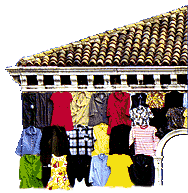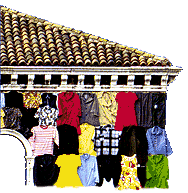
The Inhabited House
Gianni Contessi
He thinks of himself as a young outrageous performer, but turns out to be follower of professor Gottfried Semper. He considers himself as a progressive result of Ljubljana's new avant-garde and yet he confronts himself with an ancient and decisive matter such as the one of covering already cherished by the formerly mentioned professor of Hamburg and, in another respect, by the Wagnerian School, to the definition of which two great architects such as Max Fabiani and Joze Plecnik have given a primary contribution. Matej Andraz Vogrincic turns out to be an entertaining artist, but he has neither trained in pictorial studies nor in the valid Ljubljana Academy, but in its University; where art courses tell the echo of Vienna School. Through Isidor Cankar e France Stelè, the great example of Dvorak e Schlosser perhaps are still appealing to the young generations, devoted to completely different patterns. Matej Andraz Vogrincic dresses up buildings as well as determined objects by means of the clothes given by the dwellers of a place. He is neither Thomas Carlyle's Sartor Resartus nor Christo, packer to the bitter end. Campo Santa Margherita's Dressed House in Venice is also playing on several boards: one of communication, first of all, which, in spite of the learned, maybe casual references, is about the media circulation of ideas and expedients by the young artist as well as the inhabitants' capacity of re-reading their own habitat through their own clothes. The buildings' external walls are dressed in a literal sense and the coincidence, also the lexical one, between wall and dress, between Wand and Gewand hinted at by Semper in his time, speaks of the function of dressing. In the light and free-and-easy situations proposed by Vogrincic is only an excuse to remind us of how beauty is important in everyday' s life, and how a portion of ourselves lives in things besides living in houses.
[A Reference to the work] by Lorenzo Truant
An inhabitated house is a wound in the heart of the city, which also represents an unmemory from the collective memory. A place in the city which risks to exist in emptyness, to be only a phisical presence but not a space with a soul. For this reason the artist has found a way to give the house a new life, to reunite once again the body of the city through a ceremony which brings the residual energy between the material and the used clothes. From this, we experience when we put on it, sometimes we're amazed by uneasy feelings.
Habitum, habitare, habits converge in the term to have (habere) that in its deepest meaning makes reference to a way of being but also a way of existing and, once more, of awareness, watching over, cultivating day by day. In few words, it means to establish a religion, a reunification of something separated, out of sight and under a new vest or skin. Such is the colour red a weaving mill for tiles that can be considerd as the red cover of old cloaks or as loneliness in a wounded body on which the artist acts like a tailor or a doctor.
